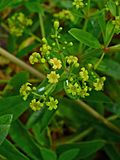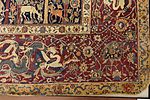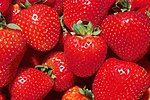Rubia tinctorum, the rose madder or common madder or dyer's madder, is a herbaceous perennial plant species belonging to the bedstraw and coffee family...
10 KB (1,181 words) - 17:35, 22 June 2024
known as madder, e.g. Rubia tinctorum (common madder), Rubia peregrina (wild madder), and Rubia cordifolia (Indian madder). Rubia was an economically important...
10 KB (956 words) - 00:26, 2 July 2024
Rubiaceae. The genus name Rubia derives from the Latin ruber meaning "red", as the roots of some species (mainly Rubia tinctorum) have been used since ancient...
5 KB (481 words) - 20:05, 19 May 2023
a traditional lake pigment extracted from the common madder plant Rubia tinctorum. Madder lake contains two organic red dyes: alizarin and purpurin....
12 KB (1,335 words) - 18:24, 24 January 2024
toward purple, which was most widely used as a dye. It came from the Rubia tinctorum plant, commonly known as Madder. It has been found on fabrics in ancient...
12 KB (1,555 words) - 09:50, 29 September 2024
species; Rubia tinctorum, also widely cultivated, and the Asiatic species Rubia argyi (H. Léveillé & Vaniot) H. Hara ex Lauener [synonym = Rubia akane Nakai...
6 KB (734 words) - 16:15, 27 June 2024
Garance des teinturiers [fr], which is the French name of the plant Rubia tinctorum. It also refers to the deep red color, also known as rose madder, from...
1 KB (122 words) - 02:37, 8 September 2023
borrowing from a West Semitic word for madder, a red dye made from Rubia tinctorum. The word Phoenician appears to be from the same root, meaning "those...
31 KB (3,198 words) - 21:29, 30 October 2024
in small amounts (as a glycoside) in the root of the madder plant, Rubia tinctorum. Quinizarin is produced by the reaction of phthalic anhydride and 4-chlorophenol...
4 KB (283 words) - 00:59, 12 September 2024
serpentina Rheum rhaponticum Rhododendron species Robinia pseudoacacia Rubia tinctorum Rubus idaeus ~ Red raspberry leaf Rubus occidentalis ~ Black raspberry...
8 KB (665 words) - 20:57, 29 October 2024
analyses, natural dyes used for carpet wool include: Red from Madder (Rubia tinctorum) roots Yellow from plants, including onion (Allium cepa), several chamomile...
111 KB (14,300 words) - 11:00, 21 October 2024
for the clothing of ordinary people was made from the roots of the rubia tinctorum, the madder plant. This color leaned toward brick-red, and faded easily...
39 KB (5,280 words) - 22:05, 31 August 2024
family Rubiaceae is named after Rubia, a name used by Pliny the Elder in his Naturalis Historia for madder (Rubia tinctorum). The roots of this plant have...
45 KB (4,220 words) - 11:45, 18 August 2024
The stems of Rubia tinctorum were used to make the rose madder dye. Rose madder was commonly used for the coats of privates....
59 KB (7,171 words) - 18:37, 31 October 2024
galium species, and dyer's madder Rubia tinctorum and Rubia cordifolia. Madder and related plants of the genus Rubia are native to many temperate zones...
51 KB (6,402 words) - 21:20, 22 September 2024
headings and decoration of illuminated manuscripts. The roots of the Rubia tinctorum, or madder plant, produced the most common red dye used from ancient...
110 KB (12,284 words) - 05:21, 24 October 2024
obtained is Rubia tinctorum. See also Vankar, P. S.; Shanker, R.; Mahanta, D.; Tiwari, S. C. (2008). "Ecofriendly Sonicator Dyeing of Cotton with Rubia cordifolia...
21 KB (2,120 words) - 02:02, 19 July 2024
small amounts (as a glycoside) in the root of the common madder plant, Rubia tinctorum, together with alizarin, purpurin and other anthraquinone derivatives...
4 KB (253 words) - 07:20, 7 January 2022
J. Althen - a Pioneer of Adoption of the Cultivation of Cotton and Rubia tinctorum in France]". Patma-Banasirakan Handes (in Armenian) (2). Yerevan: Armenian...
6 KB (488 words) - 10:58, 23 October 2024
Leucogentian violet Light Green SF D-Limonene Luteoskyrin Madder root (Rubia tinctorum) Magnetic fields (static) Malachite green Maleic hydrazide Malonaldehyde...
17 KB (1,518 words) - 16:05, 28 August 2024
analyses, natural dyes used in Turkish carpets include: Red from Madder (Rubia tinctorum) roots, Yellow from plants, including onion (Allium cepa), several...
171 KB (21,804 words) - 22:20, 1 September 2024
the alizarin dye was made from the roots of the madder plant, aka Rubia tinctorum plant. (Today alizarin is made in pure synthetic form). Dye-making...
99 KB (12,228 words) - 17:39, 28 October 2024
with a dyeing technique using the roots of the wild madder (ριζάρι, Rubia tinctorum) and providing an indelible and shiny color. 22 villages possessing...
52 KB (5,311 words) - 04:16, 28 October 2024
cochineal (Porphyrophora polonica), and the plant dye madder (from Rubia tinctorum and related species).[excessive citations] It is possible that Armenian...
34 KB (3,208 words) - 23:49, 24 July 2024
herbal origin is alizarin, which is extracted from the dyer's madder (Rubia tinctorum). Alizarin is the eponym for a number of structurally related dyes...
7 KB (796 words) - 00:06, 26 February 2024
pigment Madder Lake, traditionally extracted from the crushed root of Rubia tinctorum Maddur (disambiguation) Mader (disambiguation) This disambiguation...
816 bytes (129 words) - 02:44, 19 June 2022
J. Althen - a Pioneer of Adoption of the Cultivation of Cotton and Rubia tinctorum in France]". Patma-Banasirakan Handes (in Armenian) (2): 188–195. ISSN 0135-0536...
18 KB (1,918 words) - 14:56, 24 September 2024
J. Althen – a Pioneer of Adoption of the Cultivation of Cotton and Rubia tinctorum in France]". Patma-Banasirakan Handes (in Armenian) (2): 188–195. ISSN 0135-0536...
56 KB (5,434 words) - 07:26, 23 October 2024
areas. The fleshy roots, though much inferior to the common madder (Rubia tinctorum), are sometimes used for the production of a red dye. The genus and...
7 KB (552 words) - 03:50, 15 April 2024




















